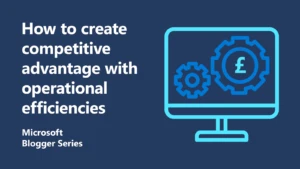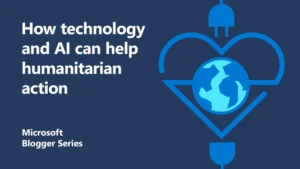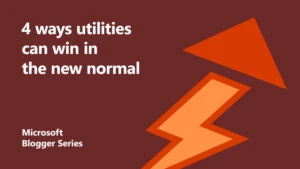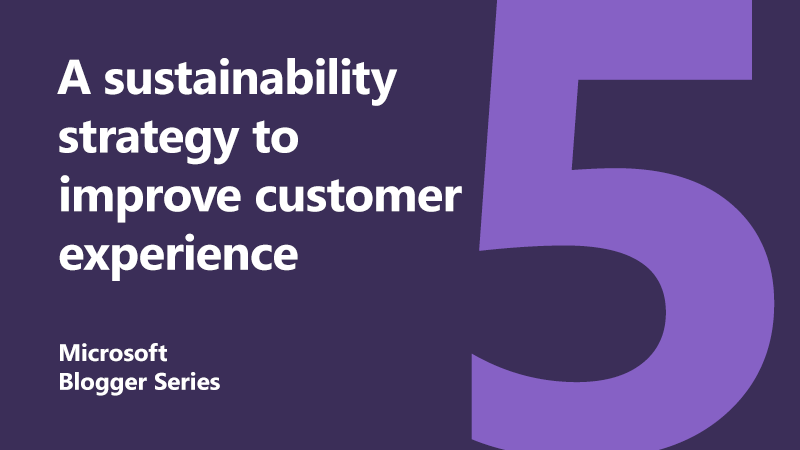
5 ways to build a sustainability strategy to improve customer experience
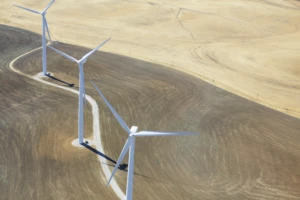 The UK is the first G7 country to legislate for a net-zero target for carbon emissions by 2050. At the same time, customers are becoming more critical of the sustainability of the services and products they consume. It’s never been more important for businesses to build sustainable practices and have a sustainability strategy. And they are doing it – according to McKinsey, 70 percent of companies now have a formal governance of sustainability in place.
The UK is the first G7 country to legislate for a net-zero target for carbon emissions by 2050. At the same time, customers are becoming more critical of the sustainability of the services and products they consume. It’s never been more important for businesses to build sustainable practices and have a sustainability strategy. And they are doing it – according to McKinsey, 70 percent of companies now have a formal governance of sustainability in place.
For Microsoft, sustainability has been at the heart of our business for quite some time. We plan to be carbon negative, have zero waste and replenish more water than we consume by 2030. In addition, we are also aiming to use data and AI to help us address biodiversity issues. Mando is a Microsoft partner who uses Azure to help utilities, telecoms, manufacturing and financial services organisations deliver better customer experiences.
In a recent webinar, we discussed the new consumer expectations on utility suppliers around sustainability. Consumers want their suppliers to help them make a difference and create a greener society. It’s no longer about organisations steadily progressing towards meeting sustainability goals. It’s quickly becoming about streamlining and revolutionising your existing processes to ensure you’re positively contributing towards a greener society.
But how can your organisation do this? And how can you support customers on their sustainability journeys? Here we are sharing the five most important points organisations need to consider when building a sustainability strategy.
1. Streamline and reduce operations
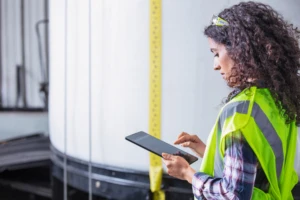 Perhaps the first thing you need to do is to understand your impact on the environment. This is where your data comes into power. You can use data to gain deep insights of how much your organisation relies on carbon, water, and more. We’d recommend starting with the Microsoft Sustainability Calculator, which can help you gain insights and understand your organisation’s carbon emissions. It can help you start the process of improving them and tracking them along your journey. AI for Earth helps organisations solve environmental challenges by harnessing AI and the cloud. You can leverage a range of open source tools that will help accelerate operations, such as analysing land cover or machine learning APIs to spot wildlife.
Perhaps the first thing you need to do is to understand your impact on the environment. This is where your data comes into power. You can use data to gain deep insights of how much your organisation relies on carbon, water, and more. We’d recommend starting with the Microsoft Sustainability Calculator, which can help you gain insights and understand your organisation’s carbon emissions. It can help you start the process of improving them and tracking them along your journey. AI for Earth helps organisations solve environmental challenges by harnessing AI and the cloud. You can leverage a range of open source tools that will help accelerate operations, such as analysing land cover or machine learning APIs to spot wildlife.
You can also take advantage of tools like Dynamics 365 to combine your data and reduce organisational silos. Power Platform is a no/low code solution to help streamline operations and reduce paper waste. Machine learning and AI is a great way of reducing paper-based workflows, while improving insights and reducing errors.
Take SSE, for example. They’re deploying analytics, AI and data visualisation capabilities on Microsoft Azure. This means they can scale and gain insights faster, empowering them to generate actionable operational and commercial insights from diverse data sets. They are also using AI to ensure wildlife aren’t negatively affected by new windfarms.
2. Improve your supply chain
For utilities, sustainability is about more than just providing renewable energy for your customers. It’s about the whole supply chain. Customers expect services that are built with sustainability in mind. The use of circular supply chains are becoming more common, so much so that a 2020 Gartner survey found that 70 percent of supply chain leaders are planning to invest in their circular economy in the next 18 months.
A circular supply chain model encourages organisations to achieve cost efficiencies, facilitate product innovation, create less waste and ultimately, minimise their environmental impact. This is key for your sustainability strategy.
Underpinning this supply chain will be technology. The cloud, IoT, machine learning and automation all have their place to drive transparency while delivering insights. Take Recycleye, for instance. They have goals to improve recycling in the waste management industry. They do this by using machine vision, AI and robotics to detect everything on a waste management facility’s conveyor belt and send it to the right place. For utilities, you can leverage this technology for predictive maintenance and real-time insights to manage customer demand.
3. Educate and improve customer experiences
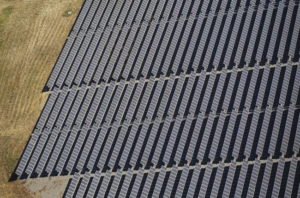 According to a 2020 BCG report, 76 percent of respondents think that environmental issues are just as – or more – concerning than health issues. When you announce or share your sustainability goals, you need to make sure you stick to them and stay accountable. For example, after we shared our ambitions in January 2020, we released a progress report a year later to share our journey and learnings with our customers and partners.
According to a 2020 BCG report, 76 percent of respondents think that environmental issues are just as – or more – concerning than health issues. When you announce or share your sustainability goals, you need to make sure you stick to them and stay accountable. For example, after we shared our ambitions in January 2020, we released a progress report a year later to share our journey and learnings with our customers and partners.
One unique position that utility organisations have is the ability to educate their customers on their own sustainability. Anglian Water provides over six million customers with a vital service. They use Azure to help track and manage water supply services to customers. They also have been trialing a smart metering scheme so customers can track their own water usage. As a result, they’ve seen an 11 percent reduction in demands on households. Customers were able to identify leaks and modify their behaviours. At the same time, Anglian Water have more insights to understand their customer’s needs.
4. Include cross-industry collaboration in you sustainability strategy
For the world to become more sustainable, everyone needs to work together. This includes collaboration at every touchpoint to improve access to new technologies and renewable energy. This will help us be successful in our collective goals. Part of this means sharing data and looking at co-innovation and investment. It’s also about working with regulators to achieve and surpass goals.
This is why Microsoft is working with Accenture and Avanade. We bring together our collective knowledge in cloud, data, AI, IoT and digital twins to help utility and energy companies support the UK’s low-carbon ambition. SSE Renewables is working with the companies to leverage technology to be more cost effective and increase the reliability and life of its assets.
This is a key opportunity for organisations to consider in their sustainability strategy. Rather than just meeting expectations and new regulations you can become ‘best in class’ and shine. A way to do this is to collaborate with other industry experts and create smart cities. By connecting a city through intelligent cloud technologies, you can build resilience, manage critical infrastructure, and make better and more sustainable decisions.
5. Build a sustainable culture as part of your sustainability strategy
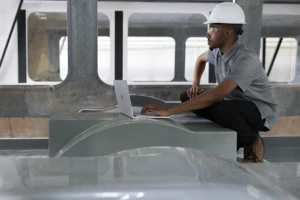 How can we best embed sustainability goals and values into the organisation? By making it part of the culture. To do this, you need to take a top-down approach. We’ve seen organisations bring Chief Sustainability Officers on to take part in key board meetings. Others have strong programmes that focus on sustainability champions to educate internally.
How can we best embed sustainability goals and values into the organisation? By making it part of the culture. To do this, you need to take a top-down approach. We’ve seen organisations bring Chief Sustainability Officers on to take part in key board meetings. Others have strong programmes that focus on sustainability champions to educate internally.
Talking about education, a key factor in leveraging technology that improves your sustainability is to ensure your employees have the skills and ability to do their best work. A strong digital skills programme will democratise skills across the whole organisation. Tools that make working remotely secure and productive can help reduce on-premises energy strain. For example, Centrica use Windows Virtual Desktop to be more agile, and only use the computing power they need, when they need it.
Build your sustainability strategy with authenticity and integrity
Culturally the mindset to be sustainable is there. And the technology to do it is there. From what we’ve seen in the last year businesses can quickly pivot and learn how to use new technology to help them stay connected and productive. When you look internally at your sustainability strategy and outwardly commit to these goals, you can show your customers your commitment authentically. And by using digital technology, you can meet and exceed these, while innovating, improving processes and meeting evolving customer expectations.
Find out more
Get the Sustainability Executive Playbook
Watch the webinar to learn how to be net zero by 2030
About the authors
 Danielle is experienced in enabling Energy organisations to use digital technologies to achieve industry focussed outcomes. It is such a pivotal time for the industry to transform, with renewable energy, sustainability and decarbonisation being at the heart of many of her customer conversations. She’s excited and fortunate that her role at Microsoft allows her to bring together our digital solutions and net-zero aspirations to help create the future of sustainable energy.
Danielle is experienced in enabling Energy organisations to use digital technologies to achieve industry focussed outcomes. It is such a pivotal time for the industry to transform, with renewable energy, sustainability and decarbonisation being at the heart of many of her customer conversations. She’s excited and fortunate that her role at Microsoft allows her to bring together our digital solutions and net-zero aspirations to help create the future of sustainable energy.
 Luke helps companies to understand and realise the value that digital services can bring in improving their customers’ experience, reducing costs within their business, and simplifying the lives of their customers and employees.
Luke helps companies to understand and realise the value that digital services can bring in improving their customers’ experience, reducing costs within their business, and simplifying the lives of their customers and employees.
Mando is a digital agency and Microsoft Gold Partner based in Liverpool. They work with ambitious leaders who need big ideas to create change in a digital world, whilst simultaneously taking care of people and the planet. With a specific focus on getting customers doing more online, they use Microsoft’s .NET, Azure and Cognitive Services platforms to deliver seamless customer experiences. This helps their clients to increase their agility and digital maturity and build value in their business using digital technology.

